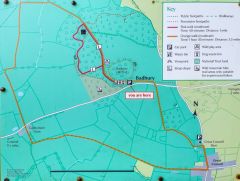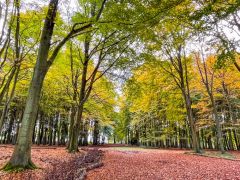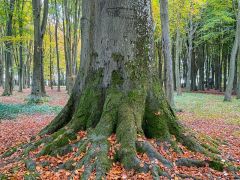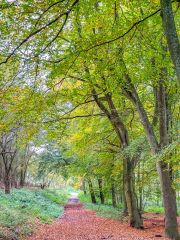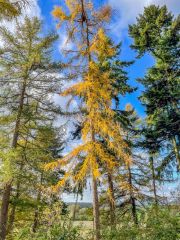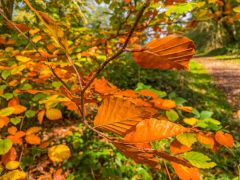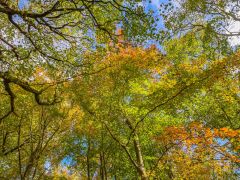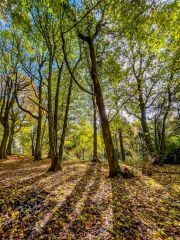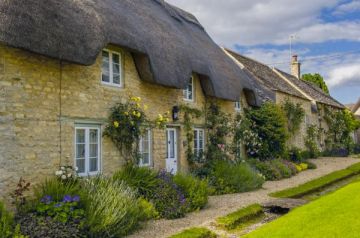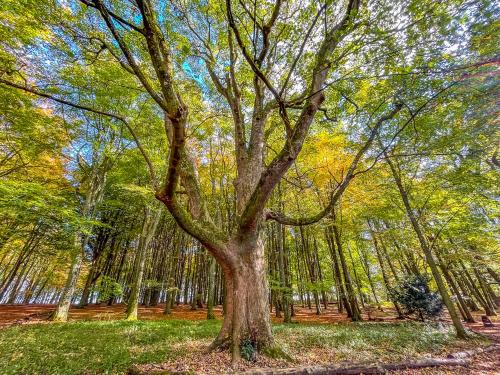
Badbury Clump (also known as Badbury Camp, Badbury Castle, and Badbury Hill) is an Iron Age hill fort just west of Faringdon, Oxfordshire. The hill fort is circular, and though you can still see the earthwork banks in places, much of the site was levelled in the 1800s.
The interior of the hill fort is planted with beech trees, making it somewhat difficult to appreciate the site from an archaeological viewpoint, but the beech trees do create a wonderfully atmospheric place to walk.

The hill fort is thought to have been built sometime around 600 BCE.
The hill fort is part of a much larger site, covering nine acres, cared for by the National Trust. Colour-coded signs direct visitors on circular walks throughout mixed woodland, with trails linking Badbury to the nearby medieval tithe barn at Great Coxwell.

The Woodland
The woodlands are home to a wide variety of conifers and deciduous trees, including larch, pine, oak, and wild cherry.
Carefully arranged benches along the trails give outstanding views over the Thames Valley to the north and the Vale of the White Horse to the south.
I managed a one-mile circular walk, taking in the hill fort and woodland, whilst relying on crutches, so anyone with a reasonable level of fitness can enjoy the site.

King Arthur at Badbury
Badbury Clump has been suggested as the site of the 5th or 6th-century battle of Mons Badonicus (sometimes called the Battle of Badon or Badon Hill) where, according to Arthurian legend, King Arthur and his native Britons defeated the encroaching Anglo-Saxons and halted their advance temporarily.
Most historians seem to accept that a battle took place, but there is no clear evidence that it took place here or that the character we now know as King Arthur took part in the conflict.
The earliest reference to Mons Badonicus came in the writings of the 6th-century monk Gildas, but Gildas does not specify the names of the war leaders on either side, the date, or the location. He does, however, note that the battle took place in the year of his birth, so he was writing about events that occurred within living memory.
The battle likely took place around the year AD 500, though dates as diverse as 482 and 516 have been suggested.
Aside from Badbury Clump, a host of other sites for the Battle of Badon Hill have been suggested by historians, including the hills that surround Bath (Somerset), Liddington Castle (Wiltshire), Badbury Rings (Dorset), and Ringsbury Camp (Wiltshire). Several sites in Wales have also been suggested.
A more recent story is that part of Badbury woodland was used as a WWII firing range by a highly secret military unit training at nearby Coleshill. The units training at Coleshill were intended to form a resistance movement in case the Germans invaded Britain.
The name Badbury appears to derive from the Old English for a fortified place (burh) linked to a person named Badda. The fortified place in this case refers to the hill fort. Who 'Badda' was is unknown.

Bluebells at Badbury Clump
Badbury Clump is known for its beautiful display of bluebells in spring, when the area in the centre of the hill fort is carpeted in lush flowers. This is by far the most popular period for visitors, so if you do decide to visit to see the bluebells, pick a weekday, as the weekends can be extremely crowded. It is also better to arrive early in the day, before the car park fills up.
The National Trust has arranged fallen tree trunks as an unobtrusive natural barrier and has erected signs to discourage visitors from walking amongst the bluebells. Please observe the signs and keep to the central paths!
Don't confuse Badbury Clump with the similarly named Badbury Ring, near Swindon.

Getting There
Badbury Clump is signposted on the north side of the B4019 about one mile west of Faringdon, on the road to Coleshill and Highworth. Though entry to the hill fort and woodland is free, there is a pay-and-display car park, operated by the National Trust. Parking is free for Trust members but there is a charge for non-members. From the car park it is a matter of a few steps to reach the hill fort.
About Badbury Clump
Address: B4019,
Faringdon,
Oxfordshire,
England, SN7 7NJ
Attraction Type: Prehistoric Site
Location: On the B4019 between Faringdon and Coleshill. There is a pay-and-display car park (free to National Trust members).
Website: Badbury Clump
National Trust - see also:
National Trust memberships (official website link)
Location
map
OS: SU262946
Photo Credit: David Ross and Britain Express
HERITAGE
 We've 'tagged' this attraction information to help you find related historic attractions and learn more about major time periods mentioned.
We've 'tagged' this attraction information to help you find related historic attractions and learn more about major time periods mentioned.
Find other attractions tagged with:
6th century (Time Period) - hill fort (Historical Reference) - Iron Age (Architecture) -
NEARBY HISTORIC ATTRACTIONS
Heritage Rated from 1- 5 (low to exceptional) on historic interest
Great Coxwell Barn - 0.6 miles (Historic Building) ![]()
Great Coxwell, St Giles Church - 0.9 miles (Historic Church) ![]()
Faringdon, All Saints Church - 1.8 miles (Historic Church) ![]()
Buscot Park - 2.2 miles (Historic House) ![]()
Faringdon Folly - 2.3 miles (Historic Building) ![]()
Longcot, St Mary's Church - 2.6 miles (Historic Church) ![]()
Farmer Gows - 2.7 miles (Family Attraction) ![]()
Kelmscott Manor - 2.8 miles (Historic Building) ![]()
